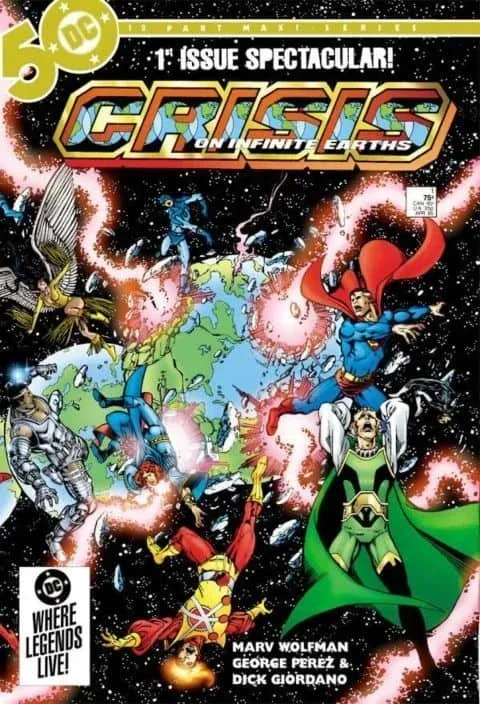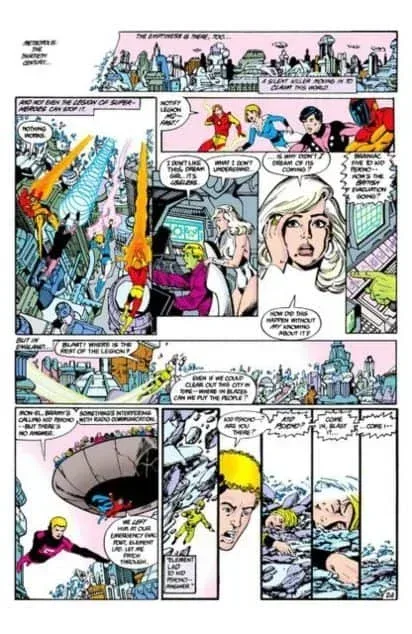
In April 1985, DC Comics started the publication of a monthly limited series titled Crisis on Infinite Earths. Created by Marv Wolfman and George Pérez, Crisis on Infinite Earths was a truly groundbreaking comic book story for DC Comics, which not only became exceptionally popular and historically important, it also marked the beginning of the Modern Age of Comic Books. In today’s article, you are going to find out several important details about this story’s plot and ending.
Crisis on Infinite Earths ended with a climactic battle between the Anti-Monitor, on one side, and Kal-L (Earth-Two’s Superman), Alexander Luthor (of Earth-Three) and Superboy (of Earth-Prime), on the other, aided by Darkseid. After defeating the Anti-Monitor, the three heroes went to a pocket “dimension”, leaving the other heroes to take care of the aftermath of the crisis.
Today’s article is going to be about Crisis on Infinite Earths, one of DC’s most important narrative events. You are going to find out what the general premise of this story was and, ultimately, how it ended, so there are spoilers ahead. Finally, I am going to tell you who survived this large crisis. Enjoy!
What is the premise of Crisis on Infinite Earths?
How Crisis on Infinite Earths came to be is a story for a separate article, but I’ll give you the digest version of it here. It all started in 1981, when Marv Wolfman, then-editor of the Green Lantern comic book, received a fan letter questioning why a character did not recognize Green Lantern even though the two of them had met three years earlier. This shocked Wolfman and he immediately came up with the idea for a story titled The History of the DC Universe.
The idea was supposed to simplify and modernize the DCU, to unite everything that had been published up to that date in one large story that would become the foundation of a modern-day DC Universe. He said:
“I knew up front, and they did too, how big this was going to be,” he said. “But, no-one knew how well it would sell, or whether it would sell at all. It was a risk DC was willing to take, because my thoughts were that DC needed a lot of help at that time, and they did too.”
(Source)
DC hired a researcher to read through every issue published by the company since its foundation, which ultimately lasted for two years. The story was planned to begin publication in 1983, but was ultimately delayed to 1985. In the meantime, it changed its title to Crisis on Infinite Earths.
This is how DC Comics summarizes the premise of the whole narrative (taken from the cover of the Crisis on Infinite Earths box set):
“Since the Justice League of America first met their Earth-2 counterparts, the Justice Society of America, the concept of a world-shaking “Crisis” has been a defining part of DC history. Now, for the first time, DC packs one incredible box set with every Crisis tale leading up to and including the industry defining CRISIS ON INFINITE EARTHS! This box set combines six previously existing CRISIS collected editions, printed for the first time in hardcover, with eight new CRISIS hardcover collections that spotlight the most important heroes of the 1980s CRISIS ON INFINITE EARTHS!
Join the Justice League, the Justice Society, the All-Star Squadron, Infinity Inc., Superman, Green Lantern and countless other heroes as they give their all to save the DC Universe!”
The story basically served as an explanation for the existence of multiple (often conflicting) storylines within the DCU. It explained that all of them, in fact, existed within a larger Multiverse of parallel Earths, which explained the discontinuities in the narration. The main narrative setting was then labeled as Earth-One (today, it is called Prime-Earth).
A cosmic entity called the Monitor is in charge of cataloging all of these universes, but he has an evil counterpart called the Anti-Monitor, who arrives from his antimatter universe and causes a multiverse-wide crisis that threatens to destroy absolutely everything. This is what happens in Crisis on Infinite Earths.

What happened at the end of Crisis on Infinite Earths?
Now, I don’t want to spoil the whole thing for you, so we’ll just skip through the middle part of the story. I can tell you, though, that the story encompasses much more than just the main limited series and has several tie-ins, all of which you can find in a good collected edition of the story. Now, let us revisit the story’s ending.
Near the end of the story, Brainiac and Lex Luthor, believing the Anti-Monitor defeated, gather all the existing supervillains and conquer the Earths that the Multiverse contains. The heroes fight them, until the Spectre manifests and announces to everyone that Anti-Monitor still lives and that he seeks to destroy reality at the beginning of time.
The supervillains travel to Oa in the past to prevent Krona’s experiment, and the heroes travel to the beginning of time to confront the Anti-Monitor. There, the Spectre begins his fight against him until the Big Bang, which finally gives rise not to the Multiverse, but to a single universe. This universe combines aspects of all the Earths, and has its own history.
With the rebirth of the universe, all the events of the Crisis were erased from history, and are only known to those who were at the beginning of time, outside the above-mentioned restructuring. Even many of them, like Superman or Robin from the old Earth-Two turn into living paradoxes, since they exist in a world in which they never have existed.
Anti-Monitor attacks once more, trapping Earth within the antimatter universe. His antimatter attacks the entire planet at once, and some heroes confront them, while the most powerful flock to Qward to confront the Anti-Monitor. After defeating him they move the Earth back to the “matter” universe, but while doing that, the Anti-Monitor awakens once more.
Only Superman of Earth-Two, Superboy of Earth-One, and Alexander Luthor of Earth-Three are left to confront him, and between the three of them and some unexpected help from afar from Darkseid, they finally destroy him completely. Alexander reveals to Superman that he knew how the lands would be restructured, and that he preserved Earth-Two’s Lois Lane in a pocket dimension before departing at the beginning of time.
The four of them then go to that dimension, while the Psycho-Pirate is locked in a madhouse, raving about the Multiverse; by doing that, he is the only character in this new universe who still knows about the existence of the Multiverse. With this, Crisis on Infinite Earths came to its end and with it, also this part of the article.
Who survived Crisis on Infinite Earths?
Now, the question of who died in Crisis on Infinite Earths and who survived is a rather complex one. In a way, most characters died out as the event actually retconned DC’s history and created one single narrative universe, save for the pocket dimension that some characters went to. The world’s that actually survived this merger were the Silver Age Earth-One, Golden Age Earth-Two, Charlton Comics’ Earth-Four, Fawcett Comics’ Earth-S and Quality Comics’ Freedom Fighters’ Earth-X. The rest was recreated as one single universe from the five remaining ones.
In theory, this means that all the characters from these periods died and were reborn as new versions of themselves in the new universe. Still, some characters actually survived Crisis and lived to tell the original tale as it happened. They were:
- Darkseid, who helped the heroes defeat Anti-Monitor;
- Pariah, a brilliant scientist who accidentally awakened the Anti-Monitor;
- Lady Quark, who ruled over Earth-6;
- Psycho-Pirate, who went mad and ended up in a madhouse;
- Harbinger, the monitor’s protégée;
- Wonder Woman of Earth-Two, who reappeared during Infinite Crisis;
- Steve Trevor of Earth-Two, ditto;
- Lois Lane of Earth-Two, saved by Alexander Luthor, Jr. of Earth-Three;
- Superboy-Prime, who fought the Anti-Monitor;
- Alexander Luthor, Jr. of Earth-Three, ditto;
- Kal-L, the Superman of Earth-Two, ditto.

These guys have not only survived Crisis on Infinite Earths, they also remembered everything that had happened and knew of the existence of the Multiverse before it was destroyed and reborn during the events of Crisis.
In the eyes of DC’s editors, this situation was the official setting for the DC Universe until 2015 (although things have changed in the years prior to Convergence), when another major crossover event, Convergence, changed things once more. Although Convergence’s primary goal was to reestablish the “Flashpoint” continuity and end the New 52 imprint, it also went back further in time and retconned Crisis on Infinite Earths, as we see the heroes of that story who went back in time to prevent the collapse of the Multiverse.
